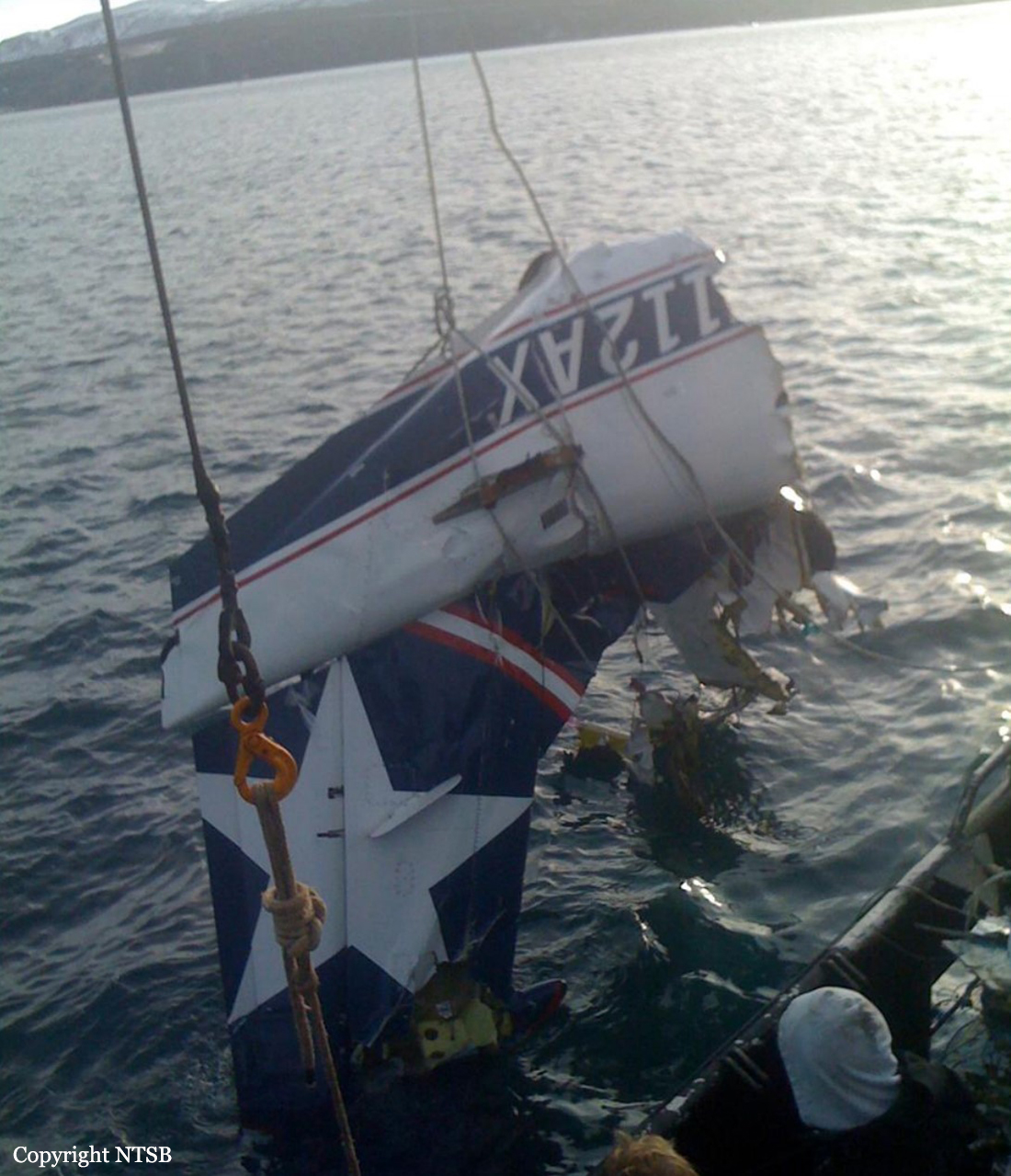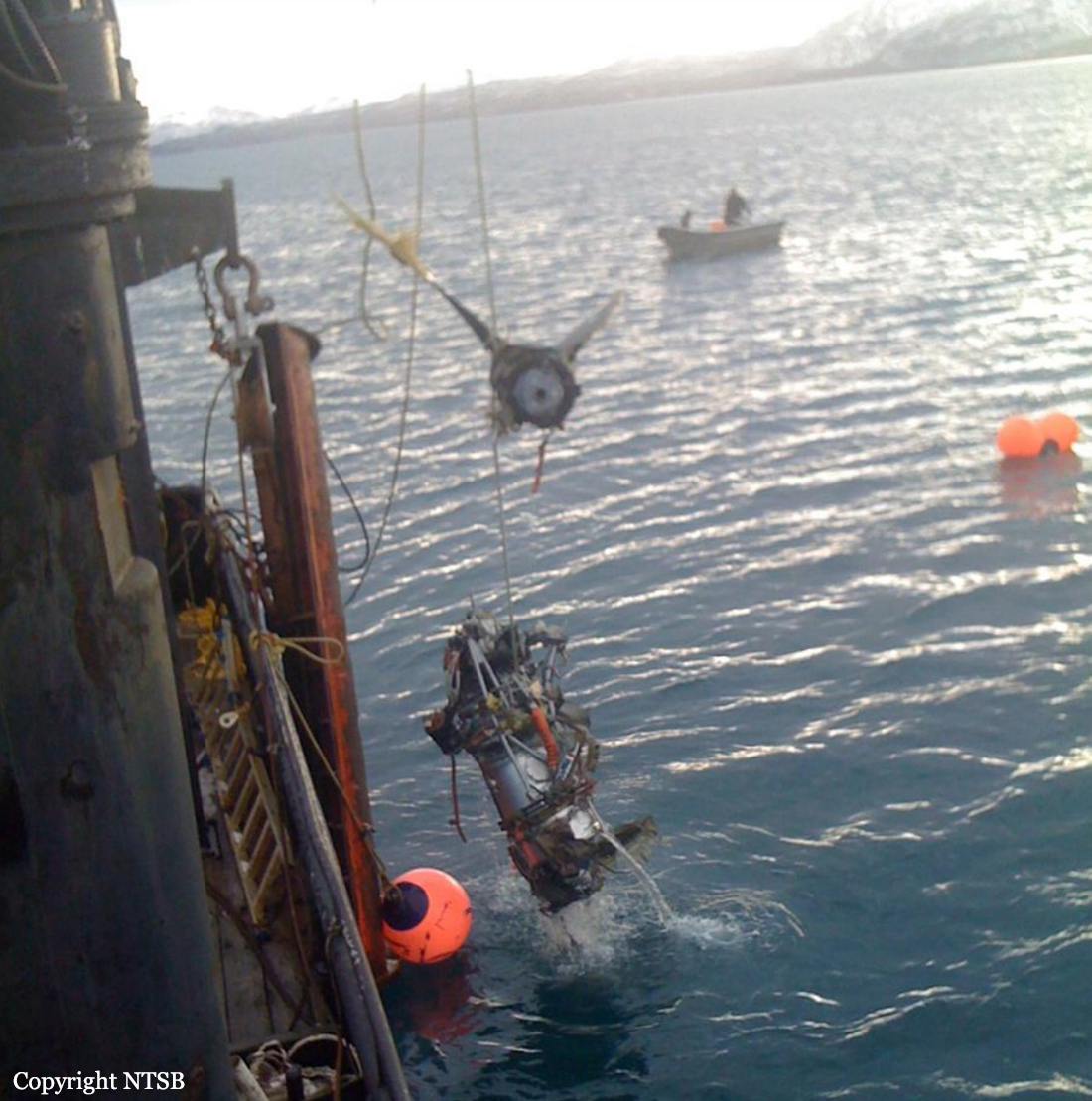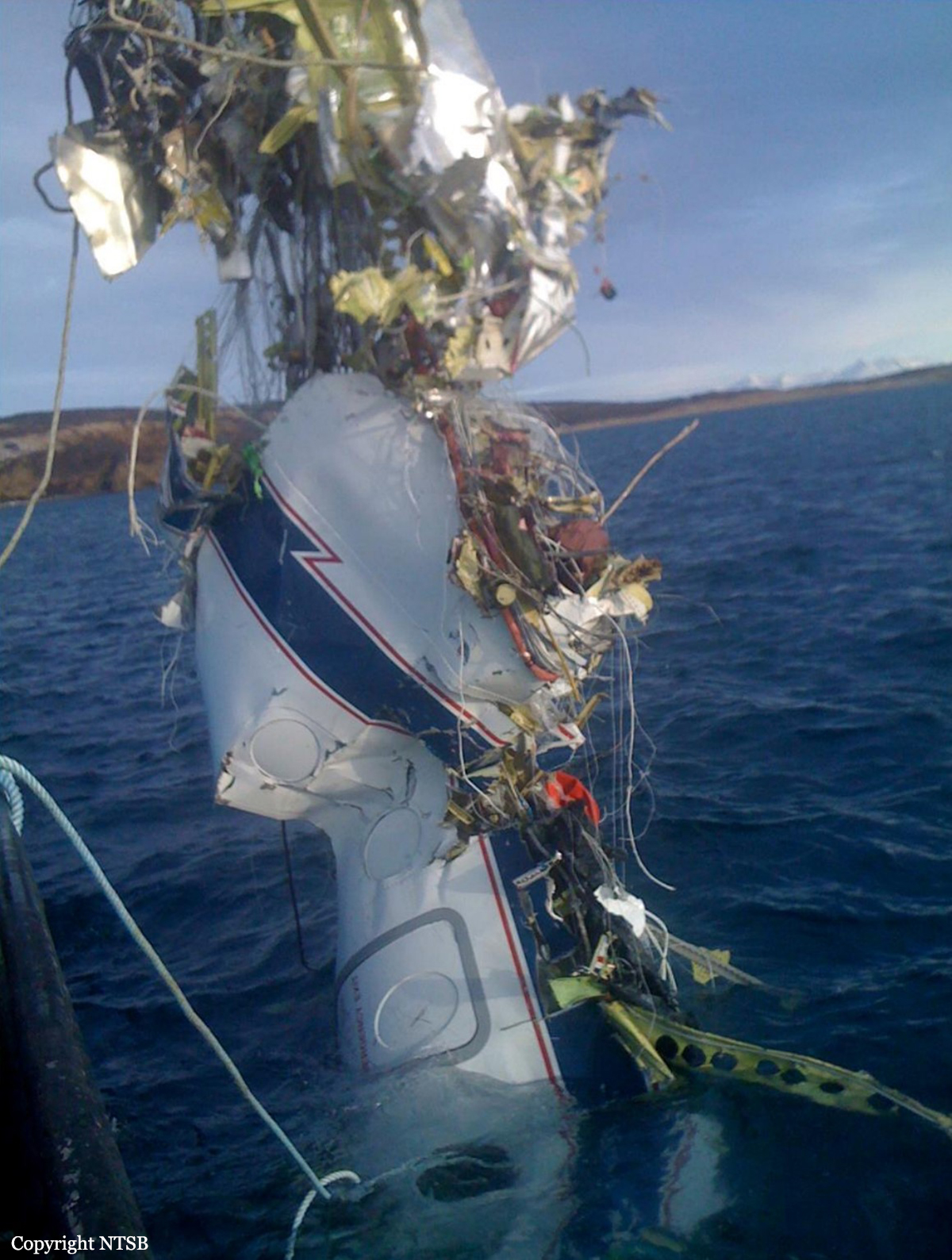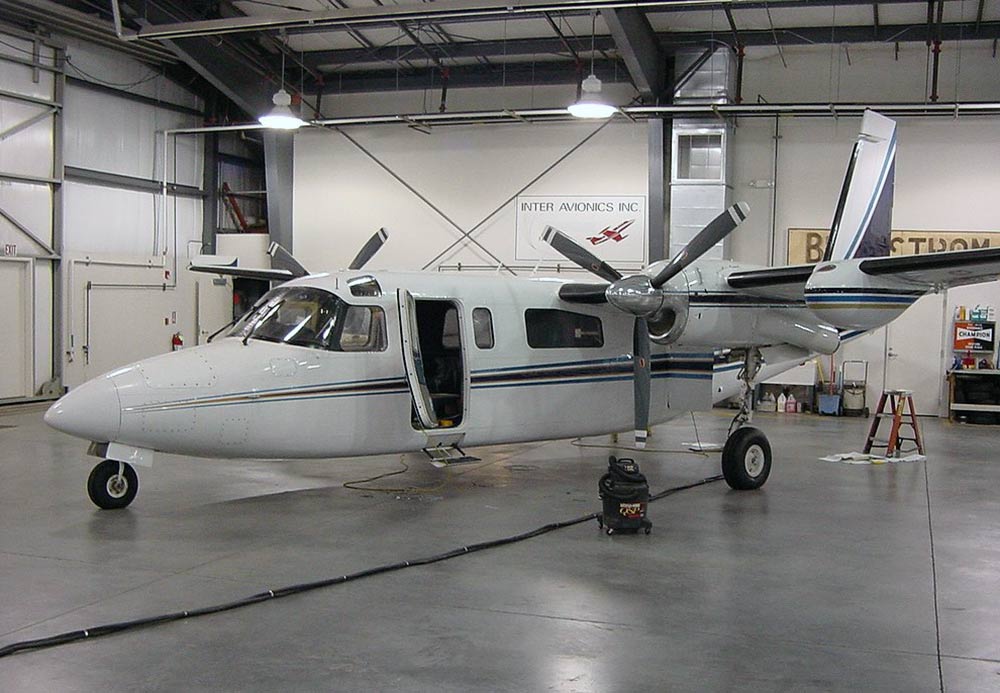Zone
Crash of a Beechcraft 1900C-1 off Sand Point: 2 killed
Date & Time:
Jan 21, 2010 at 2345 LT
Registration:
N112AX
Survivors:
No
Schedule:
Sand Point - Anchorage
MSN:
UC-45
YOM:
1988
Flight number:
AER22
Crew on board:
2
Crew fatalities:
Pax on board:
0
Pax fatalities:
Other fatalities:
Total fatalities:
2
Captain / Total hours on type:
3080.00
Copilot / Total hours on type:
280
Aircraft flight hours:
56184
Aircraft flight cycles:
45158
Circumstances:
The crew departed on a commercial cargo flight during dark night, visual meteorological conditions on an instrument flight rules flight plan. The departure end of the runway is adjacent to an ocean bay, and wind gusts up to 26 knots were reported. Local residents north of the airport reported stronger wind, estimated between 50 and 60 knots. A fuel truck operator, who was familiar with the crew’s normal routine, reported that, before the airplane taxied to the runway, it remained on the ramp for 6 or 8 minutes with both engines operating, which he described as very unusual. There were no reports of radio communications with the flight crew after the airplane departed. The airplane crashed about 1 mile offshore, and the fragmented wreckage sank in ocean water. Because of the fragmented nature of the wreckage and ocean current, the complete wreckage was not recovered. The cockpit area forward of the wings was extensively fragmented, thus the validity of any postaccident cockpit and instrument findings was unreliable. Likewise, structural damage to the airframe precluded determining flight control continuity. Both propellers had witness marks consistent with operating under engine power and within their normal operating range. A postaccident examination of the engines and recovered components did not disclose any evidence of a mechanical malfunction. Due to the lack of mechanical deficiencies of the engines and propellers, and the extensive airframe fragmentation consistent with a high-speed water impact, it is likely that the crew had an in-flight loss of control of an unknown origin before impact.
Probable cause:
An in-flight loss of control for an undetermined reason, which resulted in an uncontrolled descent.
Final Report:




Crash of a Short SC.7 Skyvan 3 Variant 100 in Mystic Lake Lodge: 1 killed
Date & Time:
Sep 20, 2007 at 1430 LT
Registration:
N2088Z
Survivors:
No
Schedule:
Mystic Lake Lodge - Anchorage
MSN:
SH1963
YOM:
1978
Crew on board:
1
Crew fatalities:
Pax on board:
0
Pax fatalities:
Other fatalities:
Total fatalities:
1
Captain / Total hours on type:
2600.00
Aircraft flight hours:
10730
Circumstances:
The airline transport pilot was departing in a twin engine turboprop airplane on a ferry flight from a remote lodge airstrip that was about 1,000 feet long and 40 feet wide. The airplane had previously received substantial damage to the nose wheel assembly on a previous flight to the airstrip. Repairs were made to the airframe, and the pilot was departing for a maintenance facility. The pilot had flown in and out of the airstrip on numerous occasions, but not in the accident type airplane. The lodge owner reported that the pilot started both engines and taxied the length of the airstrip, stopping momentarily several times. The pilot ran the engines for about 20 minutes, and then began a takeoff to the south. The airplane appeared to accelerate and remain on the centerline of the airstrip, but did not liftoff until the very end of the airstrip. The owner did not notice any unusual sounds or appearance of the engines. After liftoff, the wheels of the airplane struck and broke off the tops of trees and shrubs, that were about 6 to 7 feet above the ground. The airplane immediately veered to the right, and went out of the lodge owner's sight, but he continued to hear the airplane hitting trees until final impact. The airplane crashed in a shallow lake, coming to rest about 300 feet from shore, in about 5 feet of water. The entire cockpit area, forward of the wings, was torn off the airframe. The validity of any postaccident cockpit and instrument findings was unreliable due to the extensive damage to the cockpit. Likewise, structural damage to the airframe precluded determining wing flap settings during takeoff. Performance calculations indicated that the airplane's takeoff distance would have been about 950 feet, although the lodge owner said that in his experience, the accident airplane was capable of lifting off about half way down the airstrip without difficulty. The circumstances of the takeoff indicated that the left engine had been producing sufficient power to chop through several trees during the crash. Testing and inspection of the right engine was inconclusive, and although it was run on a test stand at reduced power, full power could not be attained due to ingestion of foreign material during the test run.
Probable cause:
A collision with trees during takeoff-initial climb for an undetermined reason.
Final Report:

Crash of a Rockwell Grand Commander 690A off Anchorage: 3 killed
Date & Time:
Jul 28, 2006 at 2037 LT
Registration:
N57096
Survivors:
No
Schedule:
Kenai - Anchorage
MSN:
690-11120
YOM:
1973
Crew on board:
2
Crew fatalities:
Pax on board:
1
Pax fatalities:
Other fatalities:
Total fatalities:
3
Aircraft flight hours:
11340
Circumstances:
The crew of the missing airplane was conducting a local area familiarization flight under Title 14, CFR Part 91. At the time of the flight, visual meteorological conditions prevailed, with occasional moderate turbulence forecast for the area. The airplane was routinely contracted for animal and bird counts, and the flight was to include low level flight simulating such a mission. The three occupants of the airplane were the pilot, company check pilot, and another company pilot riding along as a passenger. Both the pilot and the check pilot held airline transport certificates, and were experienced in the make and model of the accident airplane. The airplane was equipped with a satellite position reporting device that updated position, groundspeed, and altitude every 2 minutes. Radar and GPS track information indicated the accident airplane was flying low and slow along a peninsula coast over a saltwater inlet, and turned toward the center of the inlet. The track stopped about 3 miles offshore. The data indicated that while flying along the inlet, the airplane descended to 112 feet above ground level (water), and climbed as high as 495 feet, which was the airplane's altitude at the last data point. The airplane's groundspeed varied between 97 and 111 knots. The area of the presumed crash site experiences extreme tides and strong currents, with reduced visibility due to a high glacial silt content. An extensive search was conducted, but the airplane and its occupants have not been located. An examination of the airplane's maintenance logs did not disclose any unresolved maintenance issues.
Probable cause:
Undetermined; the airplane and its occupants are missing.
Final Report:

Crash of a Cessna 441 Conquest in Anchorage
Date & Time:
Aug 28, 2005 at 2129 LT
Registration:
N77SA
Survivors:
Yes
Schedule:
Cordova - Anchorage
MSN:
441-0329
YOM:
1983
Crew on board:
1
Crew fatalities:
Pax on board:
1
Pax fatalities:
Other fatalities:
Total fatalities:
0
Captain / Total hours on type:
50.00
Aircraft flight hours:
11049
Circumstances:
The airline transport pilot was landing a retractable landing gear-equipped turboprop airplane on a 10,900 foot long, by 150 foot wide paved runway. According to the pilot, while on approach to land, he selected 10 degrees of wing flaps, and then selected the landing gear selector switch to the down position, which was followed by "three greens", indicating the landing gear was down, locked, and safe for landing. He said that after touchdown, during the initial landing roll, the landing gear retracted, and the airplane slid on the underside of the fuselage. The airplane veered to the right of the runway centerline, and the right wing collided with numerous runway edge lights. A post crash fire ensued when the right wing's fuel tank was breached. The airplane received structural damage to the underside of the fuselage, and the right wing was destroyed. Propeller strike marks originated in the vicinity of the accident airplane's touchdown point, and extended to the airplane's final resting point, about 2,200 feet from initial contact. A postaccident inspection of the airplane by the IIC and another NTSB air safety investigator, disclosed no evidence of any pre accident mechanical malfunction of the landing gear assembly or its associated operating systems. The airplane was placed on jack stands and hydraulic pressure was supplied to the airplane's hydraulic system using a hydraulic ground power unit. The airplane's landing gear retraction system was cycled numerous times, with no mechanical anomalies noted.
Probable cause:
The pilot's failure to lower the airplane's landing gear during landing, which resulted in an inadvertent wheels up landing.
Final Report:
Crash of a Beechcraft C-45H Expeditor in Kodiak: 1 killed
Date & Time:
Jun 14, 2004 at 1137 LT
Registration:
N401CK
Survivors:
No
Schedule:
Anchorage – Kodiak
MSN:
AF-60
YOM:
1952
Crew on board:
1
Crew fatalities:
Pax on board:
0
Pax fatalities:
Other fatalities:
Total fatalities:
1
Circumstances:
The solo airline transport pilot departed on a commercial cargo flight in a twin-engine, turboprop airplane. As the flight approached the destination airport, visibility decreased below the 2 mile minimum required for the initiation of the approach. The pilot entered a holding pattern, and waited for the weather to improve. After holding for about 45 minutes, the ceiling and visibility had improved, and the flight was cleared for the ILS 25 instrument approach. After the pilot's initial contact with ATCT personnel, no further radio communications were received. When the flight did not reach the destination airport, it was reported overdue. A search in the area of an ELT signal located the accident airplane on a hilly, tree-covered island. A witness located to the north of the airport reported seeing a twin-engine turboprop airplane flying very low over the water, headed in an easterly direction, away from the airport. The witness added that the weather at the time consisted of very low clouds, fog, and rain, with zero-zero visibility. A local resident also stated that the weather conditions were often much lower over the water adjacent to the approach end of the airport than at the airport itself. The missed approach procedure for the ILS 25 approach is a climbing left turn to the south. About one minute after the accident, a special weather observation was reporting, in part: Wind, 060 degrees (true) at 11 knots; visibility, 2 statute miles in light rain and mist; clouds and sky condition, 500 feet broken, 900 feet broken, 1,500 feet overcast; temperature, 46 degrees F; dew point, 44 degrees F. According to FAA records, the company was not authorized to conduct single pilot IFR operations in the accident airplane, and that the accident pilot was the operator's chief pilot. Toxicology tests revealed cocaethylene and chlorpheniramine in the pilot's blood and urine.
Probable cause:
The pilot's failure to follow proper IFR procedures by not adhering to the published missed approach procedures, which resulted in an in-flight collision with tree-covered terrain. Factors contributing to the accident were a low ceiling, fog, rain, and the insufficient operating standards of company management by allowing unauthorized single pilot instrument flight operations. Additional factors were the pilot's impairment from cocaine, alcohol, and over the counter cold medication, and the FAA's inadequate medical certification of the pilot and follow-up of his known substance abuse problems.
Final Report:

Crash of an Embraer EMB-120RT Brasília in Bethel
Date & Time:
Oct 16, 2001 at 2130 LT
Registration:
N120AX
Survivors:
Yes
Schedule:
Anchorage - Bethel
MSN:
120-164
YOM:
1989
Crew on board:
2
Crew fatalities:
Pax on board:
0
Pax fatalities:
Other fatalities:
Total fatalities:
0
Captain / Total hours on type:
961.00
Copilot / Total hours on type:
644
Aircraft flight hours:
26295
Circumstances:
The captain and first officer were conducting a localizer DME back course approach to runway 36 in a twin-engine turboprop airplane during a night cargo flight under IFR conditions. The minimum visibility for the approach was one mile, and the minimum descent altitude (MDA) was 460 feet msl (338 feet agl). Prior to leaving their cruise altitude, the first officer listened to the ATIS information which included an altimeter setting of 29.30 inHg. No other altimeter information was received until the crew reported they were inbound on the approach. At that time, tower personnel told the crew that the visibility was one mile in light snow, the wind was from 040 degrees at 22 knots, and the altimeter setting was 29.22 inHg. The crew did not reset the airplane altimeters from 29.30 to 29.22. At the final approach fix (5 miles from the runway), the captain began a descent to the MDA. Thirty-six seconds before impact, the first officer cautioned the captain about the airplane's high airspeed. Due to strong crosswinds, the captain disconnected the autopilot 22 seconds before impact. He said he pushed the altitude hold feature on the flight director at the MDA. Eighteen seconds before impact, the airplane leveled off about 471 feet indicated altitude, but then descended again 9 seconds later. The descent continued until the airplane collided with the ground, 3.5 miles from the runway. The crew said that neither the airport, or the snow-covered terrain, was observed before impact. The crew reported that the landing lights were off. The airplane was not equipped with a ground proximity warning system.
Probable cause:
The captain's continued descent below the minimum descent altitude which resulted in impact with terrain during an instrument landing approach. Factors contributing to the accident were the flightcrew's failure to reset the altimeters to the correct altimeter setting, and meteorological conditions consisting of snow obscuration that limited visibility, and the ambient night light conditions.
Final Report:





